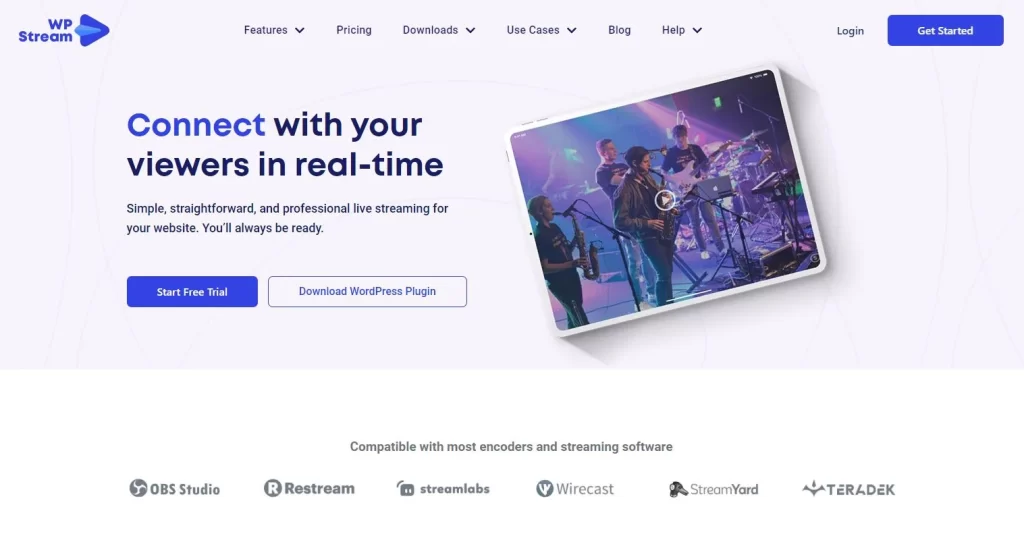Last modified: January 2025
Live streaming is an excellent way to engage with a broader audience and interact with them in real-time. In consequence, it’s no surprise the practice has become a popular means of sharing content across many different industries – and events are no exception!
There are many practical and financial benefits to live-streaming events, from creating more engaging content to generating valuable leads and boosting profits. However, knowing where to start can be a little challenging at first.
In this article, we will take you through the many reasons why you should consider live streaming your next event, the best equipment for the job, and how to go about it step by step. Let’s get started!
Why Should You Live Stream Your Next Event?
There are many reasons why you should consider broadcasting your next live event online. Whether you offer a remote attendance option for an in-person event, plan an entirely virtual event, or want to experiment with a hybrid approach (where there is a physical location but also a way to attend through the internet), you stand to gain a lot by adding live streaming functionality. For instance, you can:
- Reach a Larger Audience: Streaming an event is a great way to allow people who would not be able to (or want to) make it in person to attend. When you live stream an event, you are not bound by the same geographical constraints, space limitations, or health and safety concerns as you would be with an in-person event. This means you will be able to extend your message to a broader audience.
- Create More Engaging Content: Making your event more accessible via streaming won’t only increase your guest attendance numbers. By helping more people take part, you also stand to make it more attractive to guest speakers who would otherwise have been unwilling to make the journey to your event. This, in turn, can help you to produce more engaging content and boost your profits.
- Generate Leads: If your event becomes more open to a more varied audience, you will be creating an opportunity to attract leads who might not have otherwise been aware of your business, products, or services. Many event organizers use marketing strategies such as free or heavily discounted digital tickets to a live-streamed event to get new customers interested in what you have to offer.
- Boost Profits: We mentioned how increasing your potential audience can help boost ticket sales for your live-streamed event – but there are more ways you stand to increase profits by streaming your events. For example, you can record your stream content and offer it on a pay-per-view basis to people who were unable to attend live, which increases the potential returns from your event. Taking your event online can help cut costs, too. For instance, you can scale down on the size of the venue for your event (or, in some cases, not hire a venue at all) and, in many cases, also cut overheads like speakers’ transport and accommodation fees.

How to Live Stream Your Event (Step-by-Step)
Live streaming an event might seem daunting at first, but with the right equipment and preparation, you should be ready to go live in no time at all! We’ve put together a detailed know-how list containing all the steps you’ll need to cover to take your next event online and make it a success.
1. Plan Your Event
The first step towards live streaming your next event is to plan the event in question. Do you intend to take an existing in-person event and broadcast it online via live stream? Or are you planning an entirely virtual event from scratch?
A good tip for this step is to consider your goals for the day, your budget, and your required logistics, such as venue and equipment hire. Then, think about whether you need to book any guest speakers and how you will reach out to them. Depending on the type of event you are hosting, the planning phase can be the most in-depth part of the process, so don’t worry if this stage takes a little longer – it’s always best to get things right from the get-go!
2. Choose Your Equipment
Once you have a plan for the day, you’ll need to start considering what equipment you require to make sure you can live-stream your event. This will largely depend on the type of occasion you are planning.
For example, suppose you are hosting a webinar, with all participants attending remotely. In that case, the equipment you need might not go further than your laptop, webcam, a stable internet connection, and your chosen streaming platform. In most cases, however, when planning a live-streaming event, you’ll want to consider the following equipment as a minimum:
Camera
There are various types of cameras you can consider depending on the requirements of your event. At a basic level, many streaming services allow you to stream directly from your laptop or mobile device using a built-in webcam. However, if you’re a steamer looking for a more professional setup, you should consider investing in a DSLR camera or a PTZ (pan, tilt, zoom) camera. While the first will give you higher video quality, the second will allow for greater flexibility.
You may also want to look into running a multi-camera setup, in which case you’ll also need to invest in a video switcher to make sure you can easily change between your different video feeds.
Tripod
If your camera setup is static, a tripod can provide you with extra stability and ensure a much more pleasant viewing experience for remote attendees.
Microphone
In many cases, the audio quality of your stream can be even more important than the video quality. If you are streaming directly from your smartphone or laptop, these devices will have a built-in microphone available, but the quality of these can be questionable. An external USB or XLR microphone, on the other hand, can help to make your stream sound more professional and improve the viewing experience dramatically.
Encoder
An encoder is an essential piece of equipment for any streaming setup because it’s the one responsible for converting your raw video footage into viewable content for your live stream.
Your two base options are hardware encoders or software encoders. The first typically offers a smoother viewing experience as hardware encoders don’t require extra power from your computer to function. However, there’s a cost: You’ll have reduced customization options.
Software encoders are generally more extendable and upgradable but might not be as stable. In short, you’ll need to balance stability against flexibility when choosing an encoder and pick the one that best fits your event needs.

If you’re looking for specific recommendations, check out our complete guide on live streaming equipment, which covers our top picks for cameras, microphones, encoders, and more for a range of budgets.
3. Choose Your Live Streaming Service or Platform
Once you have settled on your equipment setup, the next step is to choose a suitable live-streaming platform to host your event stream. There is a wide range of options available, but these can broadly be broken down into two main categories: social media platforms and professional streaming platforms. Let’s take a look at both these options, their pros and cons, and the best services for each.
Social Media Streaming Platforms
As the name suggests, these streaming services are hosted on popular social media platforms. The most popular options are YouTube Live and Facebook Live, although there are other alternatives, such as Twitch, Instagram Live, LinkedIn, and Periscope (Twitter’s streaming service), that can attract a wide audience too – albeit usually for a specific niche.
Social media streaming platforms have some distinct advantages that make them a great choice when it comes to hosting your first live-streamed event. For example:
- Low Barrier to Entry: These platforms are typically very easy to set up and use, and the majority are also available for free.
- Large Existing Audience: A significant advantage of streaming through a social media platform is that you get access to the huge audience that is already using that service. Facebook Live, for example, also has a range of built-in feature s to aid content discoverability, including enabling users to share content with friends and followers.
- Built-in Monetization: Perhaps the most attractive aspect of social media streaming platforms is that they offer some options for content monetization. These can include ad revenue, subscriptions, and interactive elements like YouTube Live’s ‘Super chat’ system. It’s worth noting, however, that most social media streaming solutions don’t offer a version of a ‘pay-per-view’ model. What this means is that these platforms will be less suitable for doing things like ticketing your online events.
There are drawbacks to social media platforms, too. Aside from the limitations on monetization that we’ve mentioned, the main one is the lack of control you’ll retain over your stream content.
Most social media platforms have their own content guidelines to which you must adhere. If you fail to comply, you risk your content being taken down or demonetized. On top of this, you’ll also be limited when it comes to branding your content. This is a massive disadvantage if you are hoping to use your live-streamed event for lead generation.
Professional Streaming Platforms
Professional streaming services tend to be a little more expensive than social media platforms but come with a much broader feature set and fewer restrictions. Let’s take a quick look at how these platforms stack up against their social media counterparts and see whether they are a good idea for live-streaming your next event.
- More Control: If you’re using a professional streaming platform, you have the final word on what you broadcast. You also won’t risk your stream being taken down or demonetized without warning, or interrupted by adverts at a crucial moment of your event! In short, these tools are designed to put you in charge of your content and adapt it to your needs.
- Greater Monetization Flexibility: The best professional streaming platforms offer robust monetization options, including pay-per-view streams and more flexible subscription models. You also get far more control over your pricing model and can change things easily on the go.
- More Customization: Professional platforms will grant you complete power over your stream branding and often provide more options for improving your stream quality. The best platforms tend to offer extensions and integrations that can enable you and your users to get more out of your stream content.
This only scratches the surface of what some professional streaming services can offer. Overall, these platforms will provide you with greater flexibility and control over your content and your stream identity.
In terms of downsides, the main one is cost. Most of these professional tools have a monthly or yearly subscription fee you’ll need to pay to unlock their full potential.
Which Platform Should You Choose?
The service you end up choosing will depend on your budget and the requirements of your event. Before picking one, we recommend you check out our guide on the best streaming platforms to compare the different options and make an informed decision.
That said, if you’re looking for a platform that is suitable for streamers of various abilities and with different budgets, especially one you can adapt as you grow in confidence and begin to stream more events, WpStream is an excellent choice!

WpStream is a powerful yet flexible WordPress plugin that allows you to stream directly from your WordPress website. At a basic level, you can set up a streaming channel and go live using your computer’s webcam or a mobile device in a matter of minutes.
One of the main advantages of WpStream, however, is that it can be adapted to work for any level of streaming knowledge. If you want to create a more professional streaming experience, all you need to do is use one of the plugin’s integrations with popular streaming software like OBS, Wirecast, or vMix. In fact, you can connect to any external streaming software or multistreaming tool that supports an RTMP connection!
You can also scale WpStream’s pricing plans depending on your requirements. If you are only looking to broadcast the occasional small event, you can opt for a plan with less streaming data and support for fewer concurrent viewers. And then, if you begin to stream larger and more frequent events, you can scale up your plan at any time without being tied into a long-term contract.
4. Set Up Your Stream
Once you’ve chosen a streaming platform, you’ll be ready to start streaming your first event! Of course, exactly how you’ll go about this will depend on your chosen platform and the equipment setup you are using. As we’ve mentioned, social media platforms are pretty straightforward to use, but professional solutions like WpStream will also allow you to get started in a matter of minutes.
If you’ve picked WpStream, all you need to do to set up your live stream is to follow these three steps:
- Download and install the WpStream plugin. There is a free trial available, so you can test out all of the plugin’s features. It provides up to 5.5GB of streaming data and 100MB of recording storage.
- Add a new streaming channel and fill in all the relevant details, such as featured image, title, and bio. Then, click on “Publish”.

- If you want to record your event stream to later make it available as a VOD (video on demand, so viewers who couldn’t make it to the live event can see it), go into ‘Channel Settings’ and enable ‘Record’.
- Turn the channel on. You can now either go live through your webcam or use external streaming software.
That’s it! Using WpStream, you can go live on your WordPress website in minutes without the need for any external infrastructure.
This makes this solution perfect for anybody trying their hand at event live streaming. But, as we’ve mentioned, WpStream also makes it easier to scale and extend your streaming capabilities as your requirements and priorities change!
Take the First Steps Toward Live Streaming Your Next Event
There are many potential practical and financial benefits of live-streaming events, from reaching a larger audience and making your content more engaging to generating new leads and increasing profits. But how can you make sure you are ready for it?
As we’ve covered, there are a few essential things you should consider before you stream your next event. To summarize, you should always:
- Plan your event carefully.
- Put together the proper equipment setup to fit your event needs.
- Choose a great streaming platform that gives you control over both your content and your steam branding.
WpStream is an excellent option for any event size and budget, as you can adapt and scale the platform to meet your needs. Unlike social media platforms, this professional option will give you greater monetization flexibility and much more customization and allow you to stream directly from your WordPress site or quickly connect to external streaming tools.
Find a plan that suits your requirements today using the WpStream pricing calculator.
Table of Content







